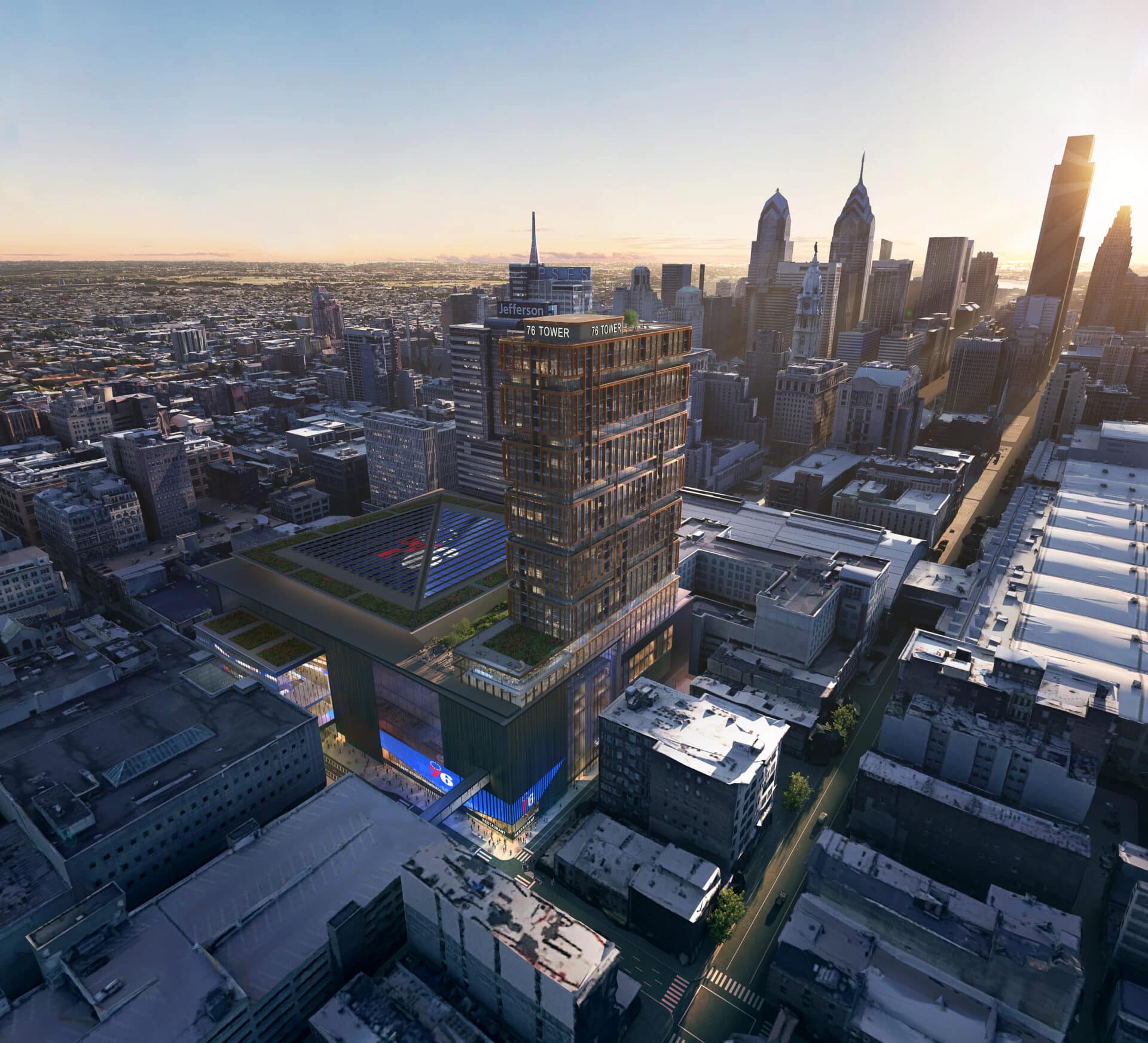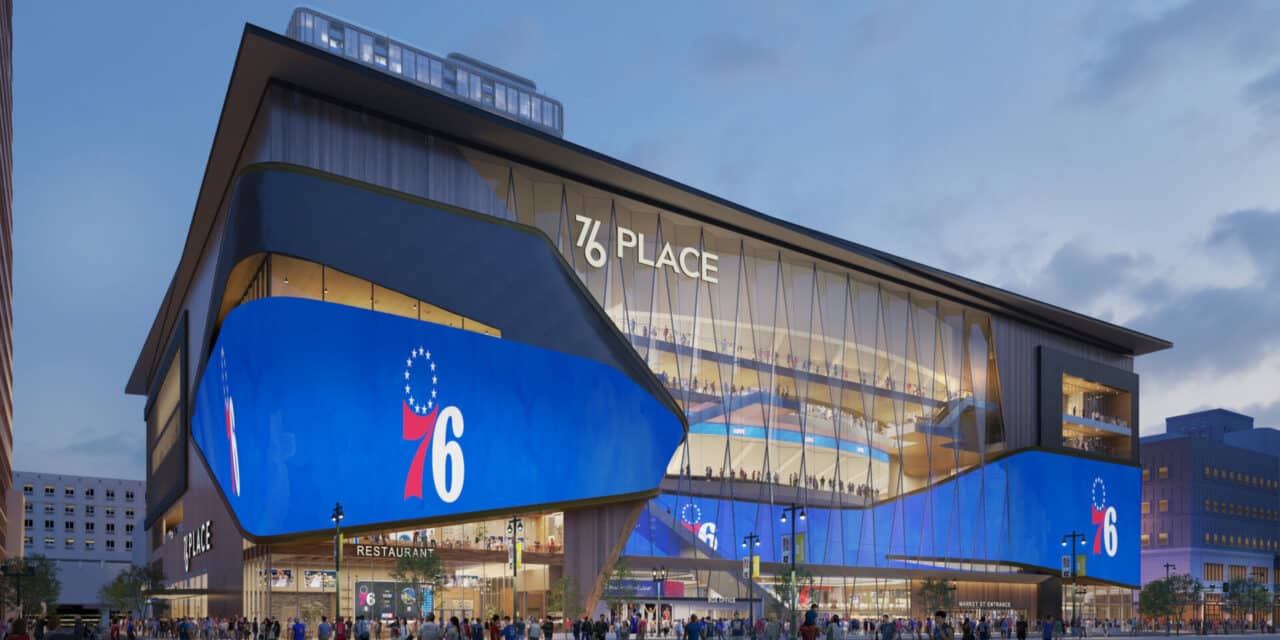SPIRIT OF 76: The newest renderings for the proposed Philadelphia 76ers arena were released in August. Gensler is the architect. (Courtesy Team)
OVG potential partner in arena development
Plans are coming into focus for a new arena for the Philadelphia 76ers, with added commitment to the city and an updated design intended to alleviate concerns about impact the project would have on the community.
The $1.3 billion development includes an investment of $250 million toward housing units, the inclusion of minority-owned business in arena development and operations, and raising the event floor to alleviate concerns of interference with operations or the major transit hub that would sit below the arena.
High-level entertainment and sports executives have shown support for the arena project, with some saying the city could support a second big league arena in addition to Wells Fargo Center, which opened in 1996 and is home to the NHL Philadelphia Flyers and the NBA 76ers, whose lease with the arena expires in 2031.
“The fact is, having two professional teams eating up all the weekend nights, it’s just not that night that is affected,” said Irving Azoff, chairman and CEO of the Azoff Group, and manager of some of music’s most popular artists. He’s also co-founder of Oak View Group, which owns VenuesNow and Pollstar.
Azoff said he was recently unable to secure a Saturday night at Wells Fargo Center for a major music client, which affected tour plans.
“We tried multiple times on the Eagles and they can’t clear the day,” he said. “It’s not just that night they eat up, it’s the whole week, in case of playoff games and that sort of thing. It’s hard to play music in a building that has an NBA and NHL team. There’s plenty of room in the Philly market for two arenas.” Azoff says market, which is ranked the seventh-largest metropolitan area in the U.S. based on population, is underserved while fans and artists prefer a downtown atmosphere for live events. Adelman has echoed the downtown sentiment, noting that 28 of 30 NBA teams play in downtown venues.
Azoff said OVG, the developer for Climate Pledge Arena and UBS Arena, two NHL venues, is in discussions with 76DevCo about forming a partnership in the arena project, although he said it was too soon specify in what capacity.
Initial plans for a new arena, to be named 76 Place At Market East, were announced last summer, following a partnership between the 76ers and local businessman David Adelman, who later purchased an ownership stake in Harris Blitzer Sports and Entertainment, which owns the team. Adelman formed a company called 76DevCo to spearhead the arena project.
The Adelman partnership brings a passionate lifelong Philly resident and 76ers fan who says the privately financed $1.5 billion development would be a win-win-win for the city, the entertainment industry and the NBA team that has called Philly home since 1963.
“We’re the only sports team in Philadelphia that doesn’t have their own home,” says Adelman, a billionaire developer who has built his wealth as CEO of Campus Apartments, FS Investments and Darco Capital.
Adelman says the arena would resuscitate a struggling part of the city’s downtown and bring in a net $1 billion in taxes on top of allowing the team to handle its operations in-house in a modern facility. He says the team’s current home is inadequate for the basketball team, despite soon-to-be-completed renovations totaling $400 million. He says the 76ers weren’t included in planning the renovations.
“They didn’t ask the Sixers or me or anyone else what we would want from them, as their tenant,” Adelman said. He says the 76ers invested $10 million of their own money to address “substandard” locker rooms. He mentions other concerns, including suite options and dressing rooms for musicians and performers, who may be relegated to using the visiting team’s locker room rather than a specifically designed modern green room.
In response, a Comcast Spectacor spokesman said, “Thanks to our $400 million transformation project, the new Wells Fargo Center is, by any objective measure, a world-class facility for basketball and hockey, and any insinuation otherwise is simply not true. In fact, we worked directly with the Sixers to design key parts of the arena’s Event Level, from health facilities to family lounges.”

New renderings of the 76ers new arena include a residential tower, part of $250 million worth of features added to the plans. (Courtesy venue)
As 76DevCo meets with community leaders about the 76 Place at Market East development, the group has committed $250 million toward mixed-income housing as part of the development and have pledged to make Black-owned business a priority in the construction and operation of the arena.
“We’re in a process where it’s still a lot of communication, still a lot of the planning phases,” says Tad Brown, CEO of Harris Blitzer Sports and Entertainment. “We’re meeting with all the different community groups to make sure that everybody throughout the Market East and the Center City District area understand the benefits that are going to be felt economically from a recreation standpoint, the concerts, the entertainment, the games, the way this is going to transform this part of downtown and create what is going to be an incredible future for Center City of Philadelphia.”
The team’s lease runs through 2031 at Wells Fargo Center, longtime home of the Flyers, owned and operated by Comcast Spectacor, which also owns the NHL team.
HSBE also owns the New Jersey Devils and operates their arena, Prudential Center. Harris and Blitzer are also part of the ownership team that in July acquired the NFL’s Washington Commanders.
Adelman, chairman of 76DevCo, doesn’t deny there has been friction between his group and Comcast, the media giant based in Philadelphia and which has a strong presence as the city’s biggest office tenant. Adelman says there’s a long list of “interference and coordination” against 76DevCo’s plans toward a new arena, and that influence in the media and local business has portrayed the arena in a negative light.
“I’m a large owner of college apartments around the country and various apartment buildings, with about 25,000 tenants. Can you imagine if I told my tenants that they can’t move out to buy their first home, that they’re trapped living in my apartment?” Adelman said.
Philadelphia is the country’s fourth-largest city for major sports teams by market size, according to SportsMediaWatch rankings. However, Wells Fargo Center at 20,000 capacity, is the city’s only indoor venue with more than 12,000 seats, which Azoff says leads to artists and their teams electing to go to stadiums and amphitheaters in the area instead.
Comcast-Spectacor says Wells Fargo Center remains a top-notch facility and is able to accommodate any concert booking request.
“As we’ve always said, we want what’s best for Philadelphia, and we agree with Philly sports fans that our newly transformed arena and the South Philadelphia Sports Complex are fantastic for basketball, hockey, concerts, and more,” the spokesman said. “The fact of the matter is that we already bring the world’s top concerts and shows to Philly, and we accommodate at least 98% of the scheduling requests from tours – there simply isn’t any significant market pressure or demand that Philly and the new Wells Fargo Center aren’t meeting. We’re going to continue doing everything we can to help the Sixers win a championship, our offer for them to buy into a 50-50 ownership of the arena still stands, and we’re excited to make major announcements soon about developing the South Philadelphia Sports Complex into a world class sports and entertainment district.”
The proposed site for the new arena is about five miles north of the stadium district, where Wells Fargo Center, Lincoln Financial Field and Citizens Bank Park are situated. The proposed site would sit on top of a major transit hub, similar to Madison Square Garden in New York and TD Garden in Boston. The 18,500-seat arena would be built on a portion of the current site of Fashion District Philadelphia, a mall in the Center City district of Philadelphia.
Updated renderings released in August show the event floor of the arena being raised to the second story, which would avoid clashing with operations at Jefferson Station, a major transit hub. Concerns locally include the impact on the city’s Chinatown neighborhood, with local organizations sharing concerns of traffic, parking and displacement due to redevelopment of historic structures.
“Like any (similar project), you’ve got to make sure you have the appropriate communication with the constituents who are going to be affected and the constituents who are going to be involved,” said Brown, who held a similar role at the Houston Rockets for almost 20 years. “It’s a normal course of action that there will be people who disagree with your plans, and we expected that. We’re doing our best to make sure that we communicate as effectively as we possibly can so that people understand the tremendous benefits that far outweigh whatever challenges we may face, whether now or down the road.” Brown said that “no door is closed” regarding whether the Flyers could potentially join the 76ers at a new arena.
Adelman says any local resistance to the project is surprising, considering the project is to be fully privately funded and benefit a part of the city’s downtown that is struggling.
“Some of those concerns are fair and we’re working to address them. We want to revitalize a part of town that is dying,” said Adelman, who made a condition of 76DevCo’s arena plans to never threaten to leave the city at any point in negotiations or development planning. “We’re taking a mall that is on the verge of low occupancy and could wind up going the way of San Francisco, where the largest mall downtown there went bankrupt.”
Up next are more community meetings, while the city conducts its own evaluations on the arena plans, which in the fall will lead to 76DevCo’s legislation toward final zoning on the project, “hopefully sooner than later,” Brown said.
Asked what happens if this plan falls through, Brown says there’s no “plan B,” and that there won’t need to be.
“We feel very good that, as we continue the efforts we’ve been undertaking and continue to have the meetings with community leaders and business leaders, we’re going to get to where we need to be because it’s the right thing for the city, our fans, and it’s the right thing for the organization,” said Brown.







